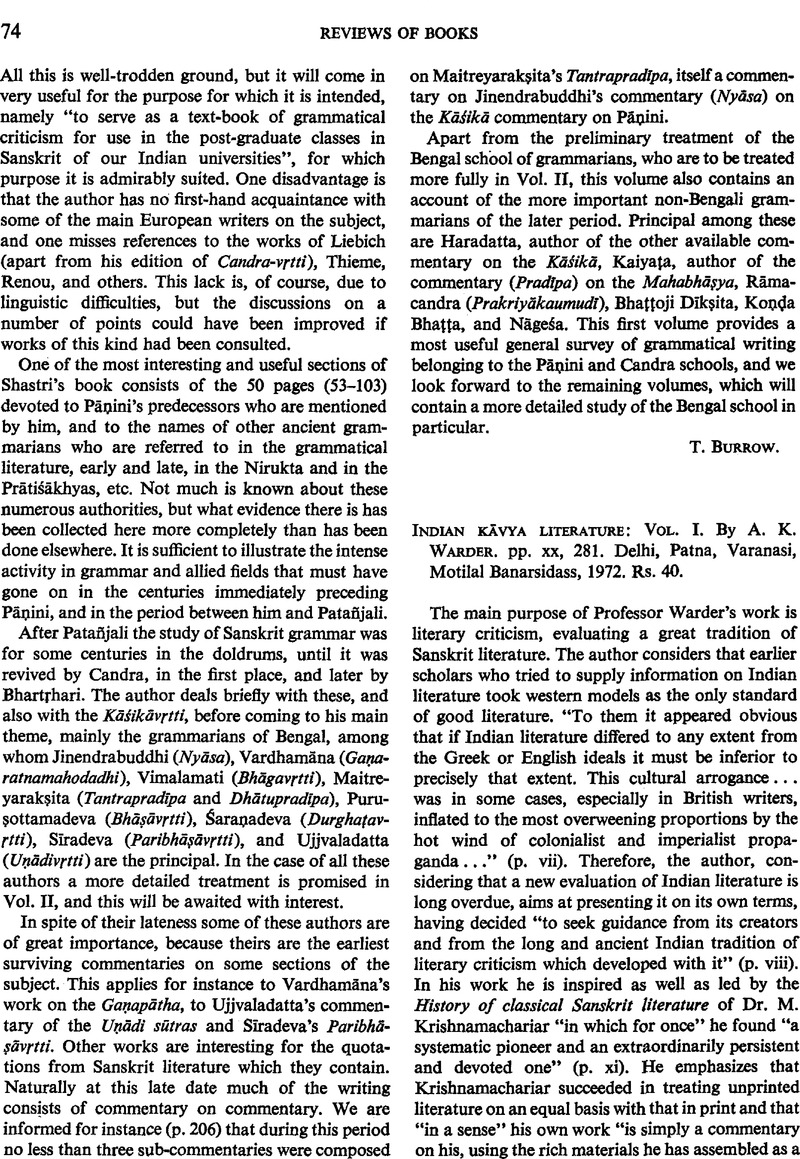No CrossRef data available.
Published online by Cambridge University Press: 15 March 2011

1 I: “Kāvya and its languages” (this concise chapter is excellent); II: “Indian aesthetics”; III: “Indian dramaturgy: the construction of plays”; IV: “Indian poetics”; V–VII: The literary forms: Drama”; “Epic and lyric poetry”; “Biography and the novel” (including campū “short story”); VIII: “The audience and the readers of kāvya and its social functions; the Writer”; Bibliography.
2 e.g. on p. 224: the much better translations of Bhartṛhari's śatakas, by P. G. Nath, M. R. Kale, etc., and the poor and incomplete translation by B. S. Miller are omitted. P. 225: the good translation of the Uttararāmacarita by P. V. Kane and C. N. Joshi is omitted. P. 232: Ratnāvalī was also issued by the Nirṇaya Sāgara Press, 1938, and translated into English by B. A. Goswami, Devadhar, and Sarma as well as by Bak Kun Bae in 1964, along with Nāgānanda (not mentioned) and Priyadarśika (completely omitted?). P. 234: Jayadeva: only the poorest edition and translation by V. Ramaswamy Sustrulu is mentioned, while the NSP edition and A. Sharma's translation are omitted. P. 234: Kalhaṇa: only the Stein ed. and transl. is mentioned, while the new critical edition with the continuation of the Rājataraṅgiṇī by Śrīvara, Śuka, and Jonarāja in the Vishyeshvaranand Indological Series, and R. S. Pandit's full translation are omitted (Stein's translation is incomplete). P. 237: under Kumāradāsa, “Nigudkar” should read “G. R. Nandargikar I–X”. P. 238: Kūrma-purāṇa was critically edited and translated in The Purāṇa, Kashiraj Trust, Vārāṇasī. P. 238: Māgha: the Śiśupālavadha was translated in full into French by H. Fauche. P. 239: perhaps the best Kāvyaprakāśa edition is the critical one by Bori, 1950 (not mentioned); a good translation by G. Jha (Benares, 1898) is also omitted. P. 243: Nītisāra should be attributed to Ghaṭakarpara; in Haeberlin's Kāvya-saṁgraha other short collections of stray verses, similar to the Nītisāra and typical kāvya-works, are not mentioned without any reason: viz. Aṣṭaratna, Dharmaviveka, attributed to Halāyudha; Guṇaratna attributed to Bhavabhūti, Nītipradīpa attributed to Vetālabhaṭṭa, Nītiratna attributed to Vararuci, Pañcaratna, Ṣaḍratna, Saptaratna, Vãnarāṣṭaka, Vānaryaṣṭaka; and Śṛṅgārarasāṣṭaka and Bhramarāṣṭaka, both attributed to Kālidāsa, as well as the Ku ![]() opadeśa, still preserved in MS only. PP. 243 and 244 should read “Pargiter” instead of “Parjiter”. P. 244: Purātanaprabandhasaṁgraha is mentioned, but the more important Merutuṅga's Prabandhacintāmaṇi (also translated by C. H. Tawney) and Ballāla's Bhojaprabandha (translated by L. H. Gray and J. Shastri) are omitted. P. 247: Rūpa Gosvamin: the Padyāvalī is not mentioned. P. 246: Veṅkaṭādhvarin's Viśvaguṇādarśa was translated into French by M.-C. Porcher. P. 256: Vetālapañcaviṁśatikā: there is also a Bhaviṣya-purāṇa version and a Mongolian version. P. 256: only Vidyākara's Subhāṣitaratnakoṣa is mentioned, while the very important Sūktiratṇahāra, anonymous Subhāṣitamuktāvalī, Śrīsūktāvalī, Kavīndravacanasamuccaya, Padyāmṛta-tarangiṇī, Padyaracanā, and many others are omitted. P. 258: Viṣṇuśarman: no mention is made of versions other than the Tantrākhyāyikā, viz. the Southern, Nepālī, Pūrṇabhadra, simplicior, ornatior, Jainistic (Hemavijaya), etc. No mention is made of the Hitopadeśa, Vikramacarita, Mādhavānala-Kāmakandalā-kathā, Ambaḍacaritra, Kathāratnākara, etc. On pp. 231–2 the Kathāsaritsāgara is included against Guṇādhya as one of the versions of the Bṛhatkathā. The Kathāsaritsāgara is connected with the Bṛhatkathā, but cannot be considered as its version; it is a separate work.
opadeśa, still preserved in MS only. PP. 243 and 244 should read “Pargiter” instead of “Parjiter”. P. 244: Purātanaprabandhasaṁgraha is mentioned, but the more important Merutuṅga's Prabandhacintāmaṇi (also translated by C. H. Tawney) and Ballāla's Bhojaprabandha (translated by L. H. Gray and J. Shastri) are omitted. P. 247: Rūpa Gosvamin: the Padyāvalī is not mentioned. P. 246: Veṅkaṭādhvarin's Viśvaguṇādarśa was translated into French by M.-C. Porcher. P. 256: Vetālapañcaviṁśatikā: there is also a Bhaviṣya-purāṇa version and a Mongolian version. P. 256: only Vidyākara's Subhāṣitaratnakoṣa is mentioned, while the very important Sūktiratṇahāra, anonymous Subhāṣitamuktāvalī, Śrīsūktāvalī, Kavīndravacanasamuccaya, Padyāmṛta-tarangiṇī, Padyaracanā, and many others are omitted. P. 258: Viṣṇuśarman: no mention is made of versions other than the Tantrākhyāyikā, viz. the Southern, Nepālī, Pūrṇabhadra, simplicior, ornatior, Jainistic (Hemavijaya), etc. No mention is made of the Hitopadeśa, Vikramacarita, Mādhavānala-Kāmakandalā-kathā, Ambaḍacaritra, Kathāratnākara, etc. On pp. 231–2 the Kathāsaritsāgara is included against Guṇādhya as one of the versions of the Bṛhatkathā. The Kathāsaritsāgara is connected with the Bṛhatkathā, but cannot be considered as its version; it is a separate work.
Many other examples, particularly of omissions, could be mentioned, but it must be stressed that the preparation of a bibliography on kāvya is a very difficult task which needs long preparation.